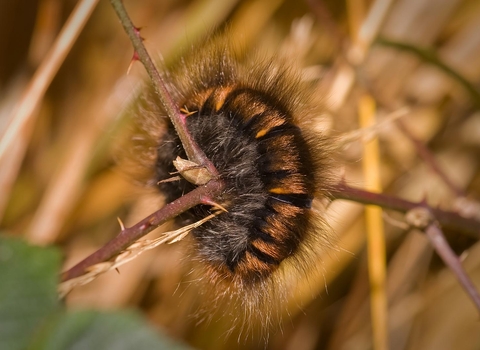Fox moth by Iain Leach

Fox moth caterpillar ©David Longshaw

Fox moth caterpillar by Tom Hibbert

Fox moth caterpillar by David Longshaw
Fox moth
The large, fluffy caterpillars of this moth are often seen in summer and early spring.
Scientific name
Macrothylacia rubiWhen to see
Moths fly in May and June. The caterpillars are most obvious in late summer and early spring.Species information
Category
Statistics
Caterpillars are up to 7 cm longMoths have a wingspan of 4-6.5 cm
Common
About
Fox moths can be found in a wide range of habitats, including heathlands, damp meadows, grasslands, and open woodlands. They get their name from the foxy, orange-brown colour of the males - though those in the north of the UK tend to be less orange. The female moths are more of a grey-brown colour, as well as being larger. The two sexes don't just look different, they behave differently too. Female moths usually only fly at night, whilst males can be seen zipping about on sunny days. They fly low over the ground, using their feathery antennae to search for the scent of females hiding on plants.Once they've mated, female moths lay batches of eggs on grass stems, or on the leaves of plants eaten by the caterpillars - they're not fussy and will feed on a variety of species including bramble, heathers, and bilberry. You can often see the caterpillars in summer and early autumn, feasting on foodplants or crawling across footpaths as they search for their next meal. They spend the winter as a fully-grown caterpillar, tucked under fallen leaves or moss, before emerging again in early spring. They don't feed in spring, but are often seen basking in the sun. They then form a cocoon low down in vegetation, where they pupate and become adult moths, which take to the wing in May and June.
How to identify
A fairly large moth with rounded wings, with two wavy lines crossing the upper surface of the otherwise plain forewings. Male moths are orangey-brown while the larger females are more of a grey colour. Males have long, feathery antennae.In early summer, young fox moth caterpillars are black with orange bands. Older, larger caterpillars are dark on the sides and orange on top, with very long hairs giving them a fluffy appearance.
